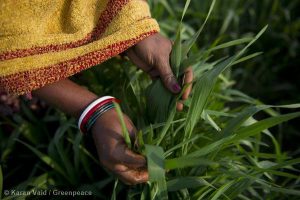Hilly terrain and increasingly uncertain climatic conditions have restricted agricultural development in India’s hill state of Himachal Pradesh. But increased demand for vegetables due to rapid urbanisation and growing tourism have come as boon for the state, which is now pushing poly-houses (also known as polytunnels) to help farmers, particularly small and marginal ones, tide over climate changes with an assured vegetable crop, even off-season.
A poly-house works on the concept of a greenhouse that lets in light and traps heat inside. But instead of glass, it is made from polythene sheets or flexible plastic sheets.
Marginal and small farmers are the group most affected by the vagaries of nature. But the use of poly-houses for growing vegetables – promoted by the state government by offering subsidies – has increased their yield in a given cycle and also helped them harvest vegetables in three cycles each year. These small land holdings are mostly located on hill slopes near where the farmers live.
According to state government records, small and marginal farmers (with up to two hectares of land) comprise 87% of total land holdings. Medium farmers (with 2-10 hectares of land) form about 13% and large land holding farmers are only about 0.4%.
A poly-house – built as part of the state government’s ‘precision farming practices’ project – helps the farmers protect crops or vegetables from sudden hailstorms or excessive rains and erratic temperature changes. Even in harsh winters, poly-houses help farmers earn from off-season cultivation. The state has received assistance from National Bank of Agriculture and Rural Development (NABARD) for this scheme.
Jagdish Chandra, a farmer from Kandbari village near the town of Palampur, is one of those who has benefited from poly-houses. Chandra, who owns about four hectares of land, installed two poly-houses (one 105 square metres and another 250 square metres) in 2009 when the subsidy was offered for the first time. Five years later, he is happy to have shifted to the modern technique which has increased his yield by more than 70%.
“Depending on natural rain, I used to get two crops but the second was not always assured. Now I get three crop cycles in a year,” Chandra said, showing the vegetables inside his poly-house right next to his home.
He grows capsicum, tomato, bitter gourd, radish, beans and coriander using drip irrigation. The process is completely organic. “We need to keep check on the temperature inside the poly-house. If it is too warm inside, then we have the sprinkler to cool down the temperature. At other times, when it is cooler outside and warmer inside, all we do is simply open the door,” he added.
His small village has four more farmers using poly-houses to grow vegetables.
The state-government run Precision Farming Development Centre (PFDC) at Solan helps by designing poly-houses and offering training to farmers. It also provides farmers with technical assistance during the actual crop cycle. When the government offered subsidies for poly-houses for the first time in 2009, the centre trained only about eight-10 farmers per year. In 2013, this number increased to more than 50 farmers per year.
Saving water
“Poly-houses help reduce evaporation. Farmers can thus use sprinkler and/or drip irrigation and save water,” said R.S. Spehia, assistant professor at PFDC.
Scientist H.R. Sharma has dispelled fears poly-houses use excessive water – as has been the case with rose cultivation using poly-houses especially in plains.
“We are talking about poly-houses in the hills. Here temperatures are lower (compared to plains) and hence evaporation is less. Moreover, we promote poly-houses with drip irrigation, which further lessens the water use,” Sharma, who is principal scientist at the Regional Horticulture Research and Training Station at Mashobra in Shimla, said.
The state government provides as much as 80% of the costs while the farmer needs to pitch in the remaining 20%. The subsidy includes a water harvesting system with the poly-house, explained a government official.
“Productivity…especially for ‘poly-house suitable crops’ such as capsicum, tomato, peas, beans, cucurbits etc. have shown significant increase,” Spehia said.
For example, production of tomatoes increased by 15% comparing 2007-09 and 2010-12. The production of beans and cucurbits increased by 13% during the same period.
By December 2013, 13,500 poly-houses had been constructed. An area of 147 hectares had been covered under protective cultivation. This far exceeds state government targets. In February 2013, chief minister Virbhadra Singh had said during his budget speech: “I propose Rs 100 crore (about US$16 million) to popularise farming inside poly-houses to augment farmers’ incomes. The target is set for constructing 4,700 poly-houses.”
“We have been recommending naturally ventilated poly-houses of bamboo, locally available, which can be used with certain modifications to cut the initial investment,” Spehia said.
